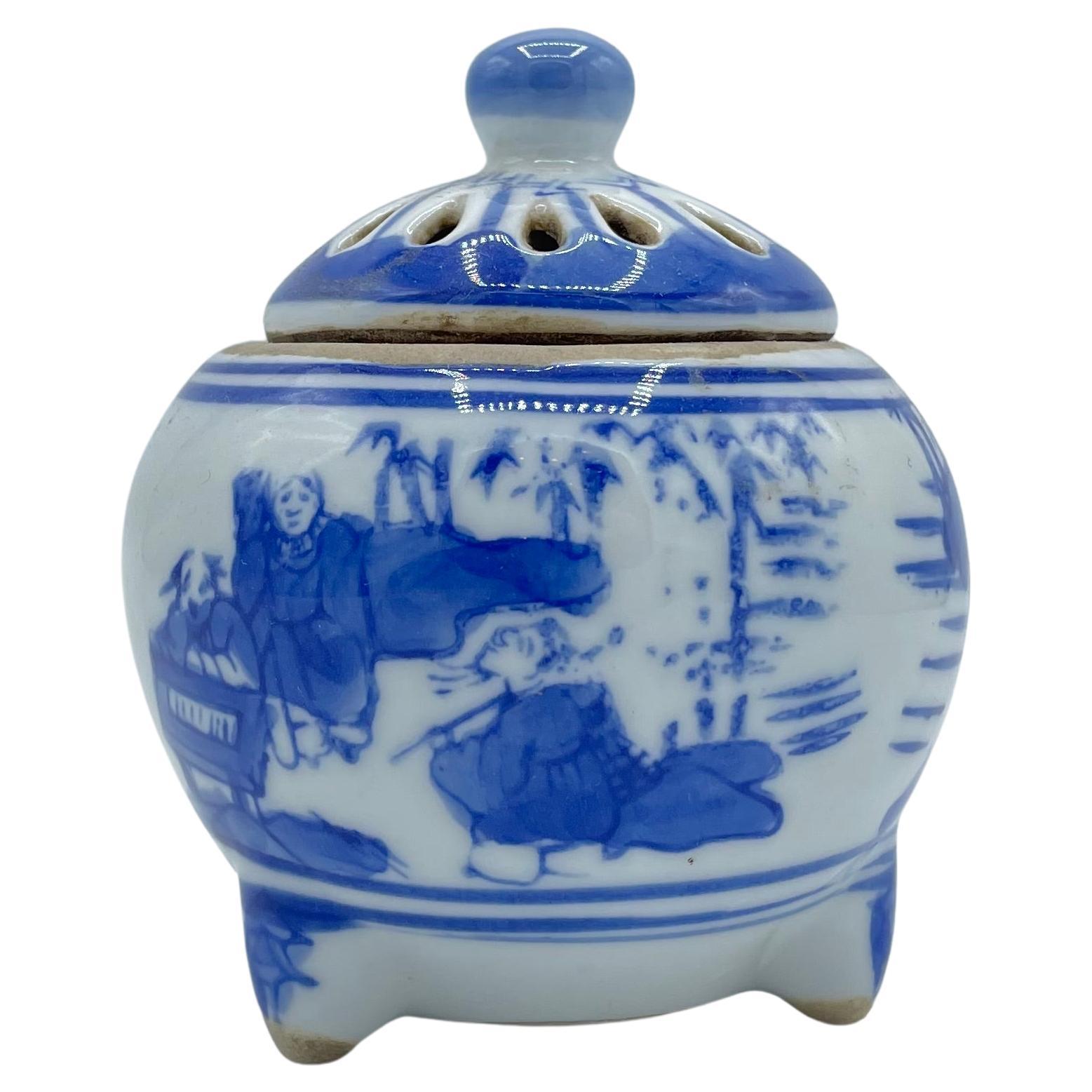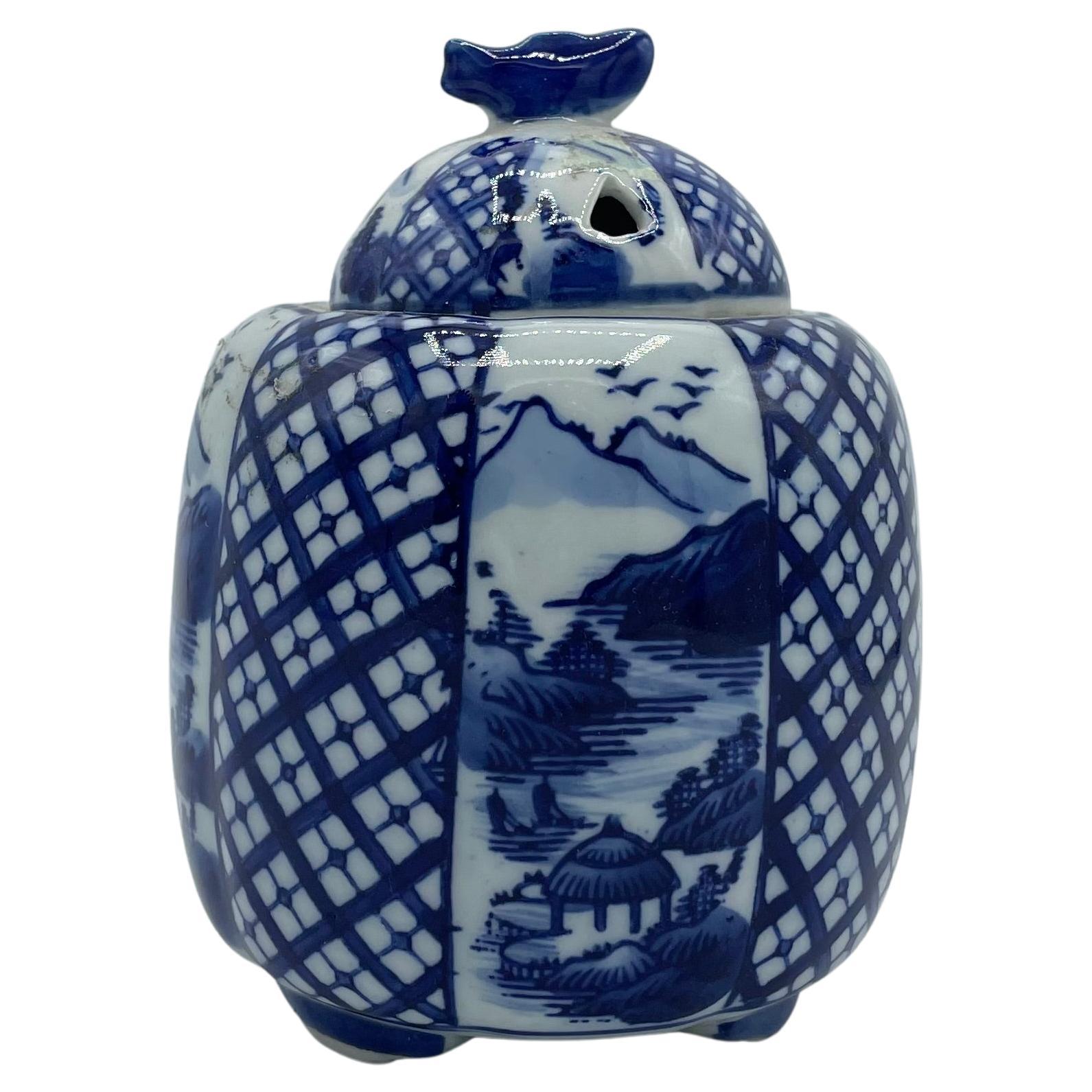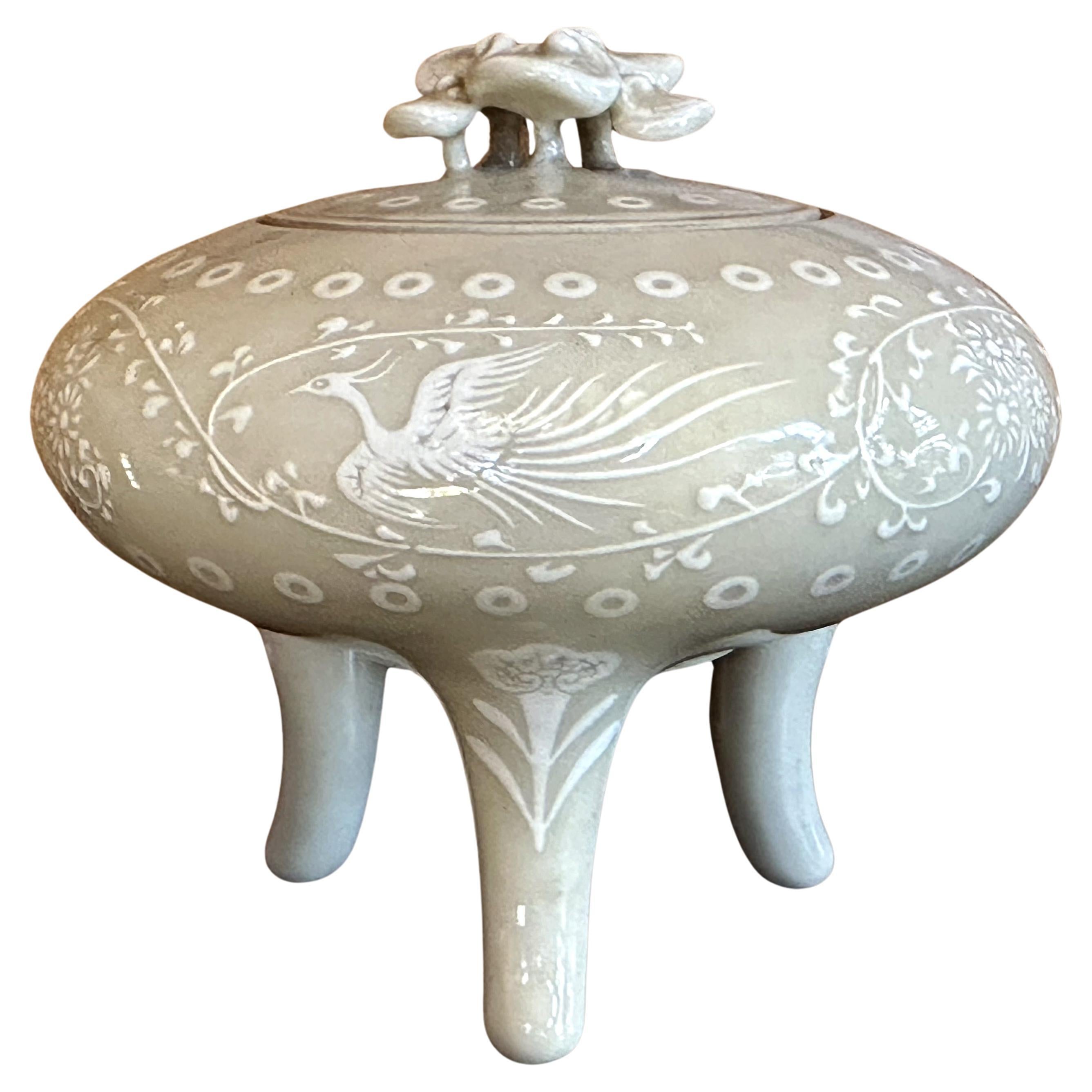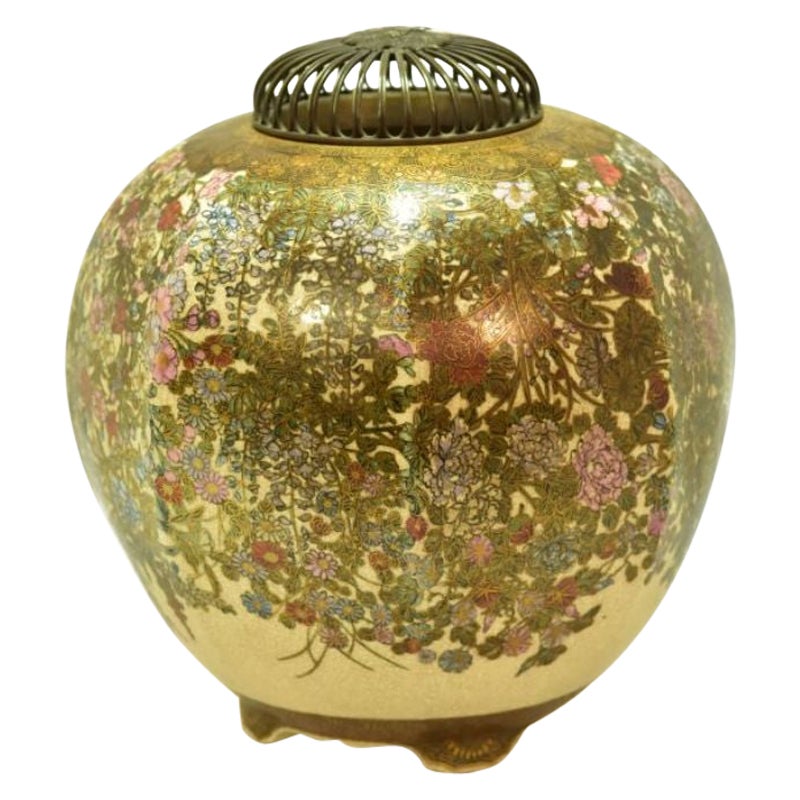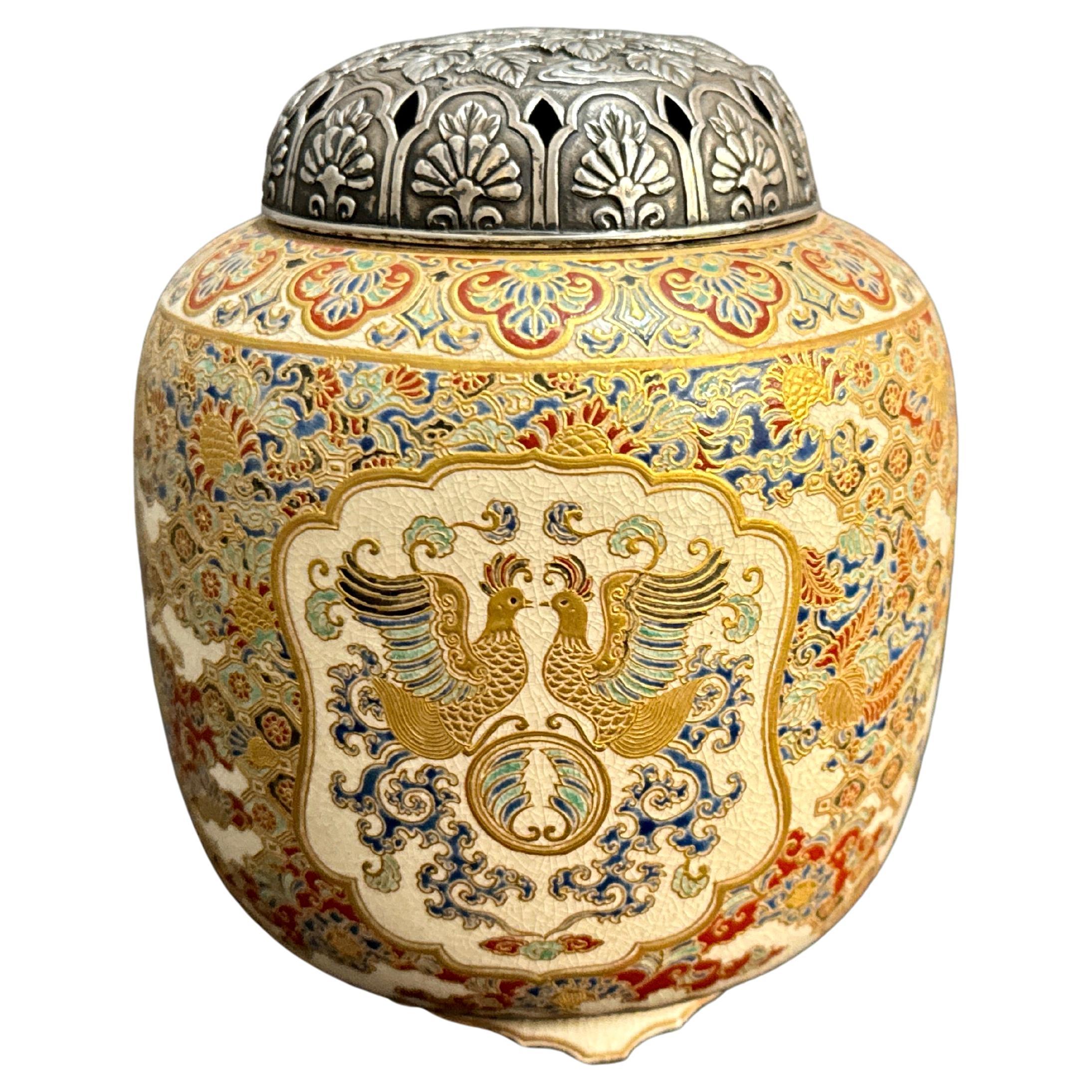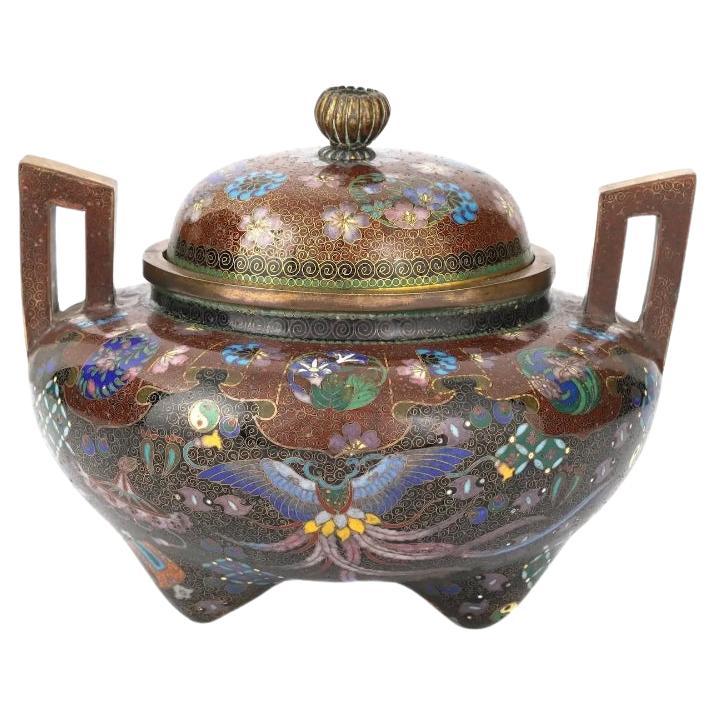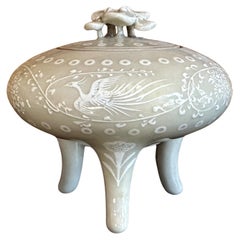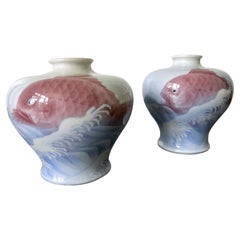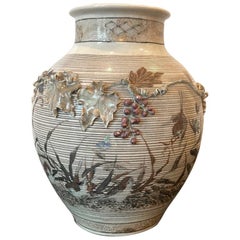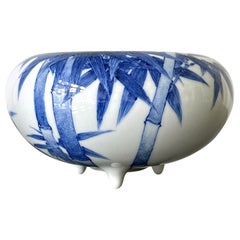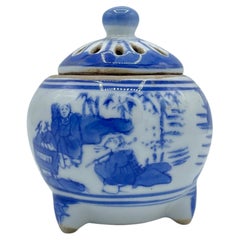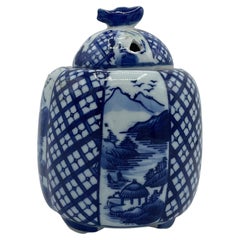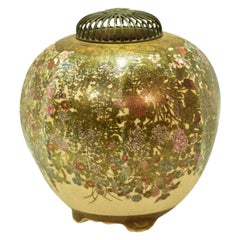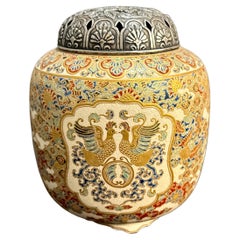Items Similar to Japanese Glazed Ceramic and Silver Koro Incense Burner Makuzu Kozan
Want more images or videos?
Request additional images or videos from the seller
1 of 20
Japanese Glazed Ceramic and Silver Koro Incense Burner Makuzu Kozan
$6,800
£5,198.96
€5,988.15
CA$9,528.88
A$10,638.10
CHF 5,574.21
MX$130,220.83
NOK 70,792.48
SEK 66,748.32
DKK 44,690.21
Shipping
Retrieving quote...The 1stDibs Promise:
Authenticity Guarantee,
Money-Back Guarantee,
24-Hour Cancellation
About the Item
A tri-pod ceramic incense burner (koro) by Japanese Imperial potter Makuzu Kozan (1842-1916) circa late Meiji to the start of Taisho period (1890-1910s). A fine example of the artist's work belonging to the late part of his underglaze paint phase (started around 1887 until his death), the surface of the koro was painted in beautiful shades of blue to depict a continuous landscape not unlike a traditional ink and watercolor hand scroll. The rise and fall mountains recede and fade into the horizon and are dotted with groves of pines. The sky is painted with a beautiful subtle shade of pink, suggesting a time of sunrise or sunset. The koro is fitted with an ensuite reticulated sterling silver hoya (incense cover), pierced with swirling cloud and marked with "pure silver' in Kanji. The base is signed in underglaze blue "Makuzu Kozan Sei" within a double ring. The piece is beautifully potted in form and the decoration was done with expertise using the novel technique developed by Kozan called Fuki-e (the blow painting), in order to achieve the striking landscape known as "Mountain and Water" with sense of dimensions and gradient, the poetic effects normally conveyed only by sumi ink staining on paper. The piece comes with an unsigned tomobako (wood storage box) of a recent age.
Also known as Miyagawa Kozan (1842–1916), Makuzu Kozan was one of the most established and collected ceramist from Meiji Period. Born as Miyagawa Toranosuke, Kozan established his pottery studio in Yokohama around 1870s and later became one of the appointed artists to the Japanese Imperial household. His work was exhibited in many international fairs that the Meiji government participated at the turn of the century and won many grand prizes. Being one of the most creative ceramists, Kozan started experimenting with new chemical colors from the West in the format of his porcelain glaze around 1880s. New colors allowed him to create underglaze designs that appeared bright, smooth and glossy. He even invented his own receipt of cobalt blue to achieve a much brighter yet softer shade, as evident on this vase. To create landscape that is realistic and dimensional, more common in the western paintings, he was inspired by the native Japanese ink painting technique developed around 1900 by Yokoyama Taikan (1868-1958) and Hishidan Shunso (1874-1911) called Morotai (Hazy style) and used cobalt blue on the porcelain like ink on paper. The fuki-e technique was demanding and uniquely featured in the works of Kozan studio.
For the work in this series and also in similar koro form, see illustration on page 57 in "Makuzu Kozan I" by Dr. Yamamoto (Japanese Version, see the last photo).
- Creator:Makuzu Kozan (Artist)
- Dimensions:Height: 5.125 in (13.02 cm)Diameter: 6 in (15.24 cm)
- Style:Japonisme (Of the Period)
- Materials and Techniques:
- Place of Origin:
- Period:1900-1909
- Date of Manufacture:1900s-1910s
- Condition:Wear consistent with age and use. Fine antique condition, silver lid with patina (not polished), base ring show a tiny chip but appears to be from making process.
- Seller Location:Atlanta, GA
- Reference Number:1stDibs: LU945028886332
About the Seller
4.9
Platinum Seller
Premium sellers with a 4.7+ rating and 24-hour response times
Established in 2006
1stDibs seller since 2010
564 sales on 1stDibs
Typical response time: <1 hour
- ShippingRetrieving quote...Shipping from: Atlanta, GA
- Return Policy
Authenticity Guarantee
In the unlikely event there’s an issue with an item’s authenticity, contact us within 1 year for a full refund. DetailsMoney-Back Guarantee
If your item is not as described, is damaged in transit, or does not arrive, contact us within 7 days for a full refund. Details24-Hour Cancellation
You have a 24-hour grace period in which to reconsider your purchase, with no questions asked.Vetted Professional Sellers
Our world-class sellers must adhere to strict standards for service and quality, maintaining the integrity of our listings.Price-Match Guarantee
If you find that a seller listed the same item for a lower price elsewhere, we’ll match it.Trusted Global Delivery
Our best-in-class carrier network provides specialized shipping options worldwide, including custom delivery.More From This Seller
View AllRare Japanese Porcelain Incense Burner with Inlays Makuzu Kozan
By Makuzu Kozan
Located in Atlanta, GA
A porcelain incense burner (koro) made by Japanese potter Makuzu Kozan (also known as Miyagawa Kozan, 1842-1916) circa 1890s-1900s (end of Meiji Period). The koro features an elegant...
Category
Antique Late 19th Century Japanese Meiji Ceramics
Materials
Ceramic
One of The Two Japanese Ceramic Vases Makuzu Kozan Meiji Period
By Makuzu Kozan
Located in Atlanta, GA
Two small nearly identical ceramic vases by Japanese Meiji imperial potter Makuzu Kozan (1842-1916), circa 1890-1900s. The vases were made in the form of jarlet with swelled shoulder...
Category
Antique Late 19th Century Japanese Japonisme Ceramics
Materials
Ceramic
Japanese Porcelain Vase with Relief Surface Makuzu Kozan
By Makuzu Kozan
Located in Atlanta, GA
A rare porcelain vase by Makuzu Kozan (1842-1916) circa 1870-81 (late Meiji period). The vase is dated to the earlier work from Kozan's studio during his early period (Takauki-ware p...
Category
Antique Late 19th Century Japanese Japonisme Ceramics
Materials
Ceramic
Japanese Glazed Ceramic Bowl by Makuzu Kozan
By Makuzu Kozan
Located in Atlanta, GA
Tri-pod ceramic bowl likely used as an incense burner (koro) by Japanese Imperial potter Makuzu Kozan (1842-1916) circa late Meiji period. The signature indicates that it was produce...
Category
Antique 1880s Japanese Meiji Ceramics
Materials
Ceramic
Japanese Porcelain Vase Meiji Period Makuzu Kozan
By Makuzu Kozan
Located in Atlanta, GA
A finely decorated and glazed Japanese porcelain vase by Makuzu Kozan (1842-1916) circa 1900s Meiji Period. The vase is of a classic bottle form with baluster body and short neck. It was decorated with underglaze white magnolia blossom on a pleasant celadon background. The stamens of the flower were artistically rendered in a low relief, giving the design a realistic appeal with the dimension.
Miyagawa Kozan...
Category
Early 20th Century Japanese Meiji Ceramics
Materials
Porcelain
Rare Antique Japanese Ceramic Takatori Ware Hoso Mizusashi
Located in Atlanta, GA
This small ceramic container from Edo period Japan circa 1800s was made in the Takatori Kilns in Fukuoka Prefecture. This type of small, tall jar with a lid was specifically created ...
Category
Antique 19th Century Japanese Edo Ceramics
Materials
Ceramic
You May Also Like
Japanese Porcelain Incense Burner 1970s Karabito
Located in Paris, FR
This is an incense burner which was made in Japan around 1970s in Showa era. This incense burner is made with ceramic.
Dimensions: 8 x 8 x H10 cm
Category
Vintage 1970s Japanese Showa Ceramics
Materials
Ceramic
Japanese Porcelain Incense Burner 1970s LandScape
Located in Paris, FR
This is an incense burner which was made in Japan around 1970s in Showa era. This incense burner is made with porcelain.
Dimensions: 10 x 10 x H12.5 cm
Category
Vintage 1970s Japanese Showa Antiquities
Materials
Porcelain
Incense Burner in Satsuma Earthenware
Located in Marseille, FR
JAPAN - Circa 1900 Incense burner in Satsuma earthenware with vegetal decoration. Openwork lid in shibuichi surmounted by a flower in slight relief...
Category
Antique 19th Century Japanese More Asian Art, Objects and Furniture
Materials
Earthenware
Japanese Satsuma Incense Burner, Koro, with Silver Lid, Meiji Period, Japan
Located in Austin, TX
A fantastic Japanese Satsuma incense burner, koro, with phoenix and brocade designs and a silver lid, Meiji Period, late 19th century, Japan.
The cens...
Category
Antique 1890s Japanese Meiji Ceramics
Materials
Silver
Large Japanese Cloisonne Enamel Koro Incense Burner with Takara-Mono
Located in Long Island City, NY
A fine quality Japanese cloisonne covered koro or incense burner, Meiji era, 1868 to 1912. The piece features cloisonne handles and cover. The exterior is decorated with various desi...
Category
Antique Late 19th Century Japanese Meiji Metalwork
Materials
Enamel
Satsuma Incense Burner
Located in New Orleans, LA
This Japanese Satsuma incense burner is a decorative work of art from the Meiji period, distinguished by its exquisite craftsmanship and intricate detailing. Made from fine earthenwa...
Category
Antique 19th Century Japanese Meiji Ceramics
Materials
Earthenware
$3,450
More Ways To Browse
Blue Glaze Japan
Antique Incense
Ceramic Cloud
Japanese Incense
Antique Japanese Rings
Pink Asian Vase
Japanese Cobalt Blue Ceramics
Cobalt Blue Box
1887 Porcelain
Antique Japanese Silver Box
Silver Antique Japanese Boxes Silver Boxes
Japanese Incense Burner Antique
Pierced Pottery
Incense Box
Japanese Watercolor Paintings
Reticulated Vase
Meiji Incense Burner
Taisho Scroll
